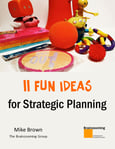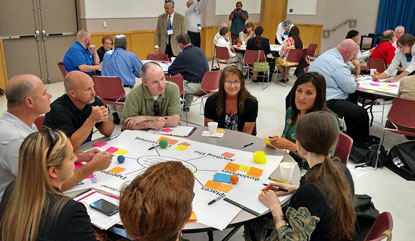(Adapted from Inside the Executive Suite by Armada Corporate Intelligence)
Two junior team members in chief of staff / program manager roles asked how to best align with senior leaders to successfully share a strategy across an organization. Each was concerned about having enough regular access to senior leaders to feel comfortable in delivering consistent communications relative to what they would be saying in other forums. The challenge is doing more than just sending out a plan and expecting people to naturally understand the organization’s direction.
The Way to Successfully Share a Strategy
What can a senior leader do to share personal perspectives and expectations to facilitate stronger strategy implementation in an organization?

We recommend that an executive team develop its own strategy brief to support better, more aligned communication, and ultimately, strategy implementation. Borrowed from the idea of a communications brief, a strategy brief will:
- Prompt greater strategic clarity and expectation setting
- Help team members who are working on communicating and implementing the plan to perform effectively and creatively
- Facilitate objectivity when judging the effectiveness and success of early strategy implementation
The strategy implementation brief contains three types of information:
- Objectives – Detailing where the strategy should lead the organization, who it will impact, and what beliefs and action will be most important to success.
- Preferences – Shares what messages, messaging styles, timing, and reinforcements pave the way for greater alignment.
- Guidelines – Laying out what the strategy communication and implementation team needs to incorporate and avoid.
Within that framework, here are the questions to answer so your team can most effectively represent senior leadership to the entire organization.
Objectives
- What is on the short list of initiatives that will move the organization forward?
Answering this question is step one in getting your strategic plan down to a bite-sized aspiration. Of all the initiatives you have planned, which handful are you, as a senior executive, going to monitor most closely? Your answer will determine whether you are going to move the needle or not.
- What are your beliefs about the organization’s current situation? What do you think the broader organization’s beliefs are about the current situation? How do they need to change?
These questions begin addressing the arc of change you expect the organization to embrace. Is change critical to taking advantage of opportunities? Is a dramatically different direction needed to ward off challenges, but only after you overcome organizational complacency? Importantly, does the broad employee base see the organization’s situation comparably to the senior team? If not, orient the change communication toward what will make sense to THEM.
- How do you expect the organization to think, behave, and perform differently with successful implementation?
Don’t spell out dozens of things you need employees to address so you can affect the desired strategic changes. Push your executive team to spell out five or fewer thinking and performance changes you are looking for from the organization. Pick only ones that will make a noticeable difference in results.
Preferences
- What are the most important messages to convey and reinforce?
Identify the short list of messages most important for each target audience. Then do whatever homework you can do to see how those messages will resonate with your audiences. Far better to talk to audiences in ways that resonate with them versus ways that make sense to the senior executives.
- What are the rallying points you will personally use to build momentum? How consistent do you expect to be in your own communication and messaging?
Share the talking points you expect will work best for you when you are interacting personally with audience members. Spell out how comfortable and confident you are in staying consistent with your messages. If you expect to shift them or are prone to get swept up in the moment and venture into new territory, let your team know to check back frequently for updates.
- What emotions are relevant and okay to leverage to increase communication receptiveness?
Even if you’re data-driven and uncomfortable with emotional appeals, they do play an important role in business communication. Lay the groundwork for integrating appropriate emotions to move hearts in addition to minds.
Guidelines
- Where are you looking for the team and others closer to the broader employee base to exercise their own creativity?
Once you’ve provided the foundation for your implementation team, let them know where they have room to bring their own ideas and variations to your thinking. Don’t expect them to be order takers, simply carrying out everything you dictate. Give yourself the advantage of tapping into the team’s expertise.
- What touch points and feedback do you want from the implementation team?
This goes along with the previous direction. Share how involved and active you expect to be with the team. Make sure everyone understands how much latitude they have to act vs. circling back to the executive team for frequent check-ins.
- What adjustments are you prepared to make if things seem off track?
Knowing your commitment level to the current direction helps the team plan for appropriate levels of change. Have you chosen an unwavering path, or are you experimenting your way into a new strategy, expecting to learn and adapt for the foreseeable future?
To Successfully Share a Strategy, Don’t Keep Your Implementation Team in the Dark
While it’s hardly statistically projectable, the two individuals asking how to align with senior leader messaging are likely voicing the sentiment of junior team members on the hook to implement your senior-level strategies. That’s why a strategic implementation brief is valuable for paving the way for an organization’s successful strategy implementation. – Mike Brown





